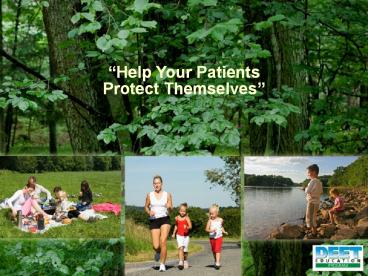- PowerPoint PPT Presentation
Title:
Description:
Help prevent mosquito- and tick-borne disease ... After time outdoors, check for insect bites and ticks. 14. Special Populations ... – PowerPoint PPT presentation
Number of Views:12
Avg rating:3.0/5.0
Title:
1
Help Your Patients Protect Themselves
2
Personal Protection
- Avoid areas with dense mosquito populations (wet,
wooded, etc.) - Avoid the peak times for mosquitoes two hours
before after dawn dusk - Use clothing as a protective barrier
- Use EPA-registered insect repellents on exposed
skin
3
Why Repellents?
- Help prevent mosquito- and tick-borne disease
- Repellent use decreased risk by 2x in a
case-controlled study in Australia (Harley, et
al., 2005) - Respondents with no/infrequent insect repellent
use 2x more likely to have evidence of past
dengue infection vs. those using always/often in
Matamoros, Mexico (Ramos, et al., 2008) - Loveland, Colo., had 3x higher WNV rate vs.
nearby Fort Collins in 2003. Difference in
repellent use (significantly great in Ft.
Collins) possible factor (Zielinski, et al.,
2008)
4
Regulation of Repellents
- CDC and California public health agencies
recommend consumers use EPA-registered active
ingredients - DEET, oil of lemon eucalyptus (OLE),
- picaridin, IR 3535
- EPA registers products after reviewing extensive
efficacy, safety data - The EPA says registration indicates the
materials have been reviewed and approved for
efficacy and human safety when applied according
to the instructions on the label. (CDC)
5
Types of Active Ingredients
- EPA-registered products most effective (CDC)
- - conventional repellents DEET picaridin
- - biopesticide repellents OLE IR3535
- Natural products
- Many are untested for efficacy
- Very little toxicity data available
- Less effective (Fradin Day 2002)
- Possible allergens (Day Rutlege, 2008)
- Many last at most 20 minutes
- No more effective than cooking oil or other
barrier
6
Natural Repellents
- Limited efficacy
- Efficacy testing not required
- Many consumers make their own OLE concoctions
- These are ineffective
- Many essential oils are highly irritating to skin
and must be used cautiously on children
7
DEET
- DEET used for more than 50 years, most widely
studied repellent active ingredient - DEET has been shown to be an extremely safe and
effective repellent and remains a very important
option for consumers. CDCs Lyle R. Petersen,
M.D., M.P.H. - Urban legends on safety have a life of their own
and are generally without foundation - (For specifics, please ask during QA)
8
The Science
- Industry-sponsored studies
- Leading companies conduct rigorous studies per
EPA guidelines - Competitive claims from less effective,
non-registered products lead to consumer
confusion - Examples on the internet
- Independent studies
- Scientists continually study DEET, potential
alternatives - Fradin, Day 2002 NEJM considered benchmark
- Copies available upon request
9
Concentration Protection Time
- DEET
- 5 provides approx. 90 minutes
- 10 provides approx. 2 hours
- 30 provides approx. 5 hours
- Protection Time Variables
- Weather conditions
- Biting pressure
- Race
- Gender
- Activities (swimming, perspiring heavily)
- Body chemistry
10
Adverse Events
- The most commonly reported AEs
- Eye irritation
- Formulations contain alcohol
- VERY rarely, skin rash
- Thought to be associated with other ingredients
11
Registry Details
- More than 5 billion applications of DEET during
7-year Registry period - Overall risk of clinically significant adverse
events is very low Thomas G. Osimitz, Ph. D.,
CDC conference, 2005 - No association with seizures
- Copies of Registry Poster presentation at CDC
meeting available upon request
12
Using Repellents
- Read, carefully follow label directions
- Apply to exposed skin, not under clothing
- Apply evenly, rub product onto skin to ensure
even coverage (mosquitoes can find an uncovered
spot the size of a dime) - Wash off after returning indoors
13
Repellents on Children
- AAP recommendations
- Up to 30 concentration DEET-based repellent for
all over 2 months old - Adults should apply to young children
- Adult puts repellent on his/her hands, then
applies on childs skin - Dont spray randomly in the air
- OLE should not be used on children younger than 3
years old - After time outdoors, check for insect bites and
ticks
14
Special Populations
- Pregnant women/ Nursing mothers
- CDC recommends pregnant and lactating women use
repellents as needed - Elderly
- At special risk for serious WNV illnesses
- Children under 2 months old
- Use mosquito netting
- Children at camp
- Use higher concentrations for extended coverage
(30) - Reapply only when bugs start biting again
15
Summary
- Encourage patients to
- use EPA-registered repellents
- read the instructions before use
16
More information www.cdc.gov www.cdph.ca.gov www.
sdcounty.ca.gov www.deetonline.org
17
Further questions toMs. Susan LittleExecutive
DirectorDEET Education Program202-833-7315 /
slittle_at_cspa.org1-800-No-Bites
www.deetonline.org































